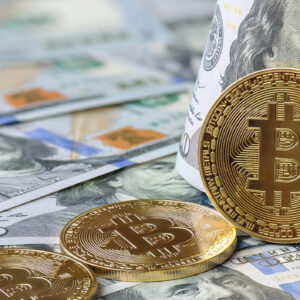What Every Veteran Should Know About Money & Cryptocurrency
“What the hell is cryptocurrency? How is it better than our money now? Isn’t it risky?” I hear these questions all the time when the topic of cryptocurrency comes up. The thing is, in order to understand why cryptocurrency is better currency than fiat (also known as the U.S. Dollar), you have to learn about the history of money.

I hear these questions all the time when the topic of cryptocurrency comes up.
Financial education is not taught in most schools, which is why people grow up believing the financial system we currently have in place is the “safest” system to follow. What if I told you that is all bassackwards, and here is why…
Trading/Bartering:
In the beginning, currency was often done in forms of trade or bartering. The problem with bartering was disputes over whether different products or services being exchanged were of equal value. One example would be trying to negotiate how many chickens are worth one cow? What has more value? Chickens lay eggs, and cows provide milk. What if the chickens are old and die within the year? What if the cow is sick and dies within months?
How do you know for sure the person you are bartering with is truly giving you equal value, or being honest about what they are trading? You can see how trading goods based on someone’s integrity often presented problems. The question then became, what could be exchanged as an agreed form of currency?
In order to answer this, these six key factors needed to be met.
- Scarcity – Is there only a certain amount of it in existence?
- Divisibility – Can it be cut down into smaller pieces or recombined into larger pieces?
- Durability – Is it available globally versus just nationally?
- Fungability – Can it be tested to see if it’s real or fake?
- Portability – Can it be sent overseas internationally?
- Programability – Can it generate a functional economy?
Gold Coins:
The answer to these questions ended up being gold. It was scarce because it required mining, and there is only so much gold you can mine until it runs out. It was divisible because it could be melted into heavy rectangular bars, and minted into smaller coins.
It was durable because minors could dig for it anywhere in the world. It was fungible because people could determine the difference between fools gold and real gold. It was portable because it could be shipped internationally across oceans. It was also programable because there was enough of it to generate a functioning economy.
Since gold seemed to meet the criteria, it became the agreed upon exchange of value. However, it did have one caveat. This form of exchange became somewhat of a “heavy” burden. Bags and chests of gold coins literally weighed people down.
Can you imagine having to pay for groceries using only dimes, quarters, nickels and pennies? You would have to carry so many bags of change with you all the time. It turns out that gold coins (and coins made from other metals) was not a very functional system. All in all, the people discovered that a seventh key factor was “functionality.”
Coins to Cash:
Fast forward, and the government decides to turn coins into cash. They invented (or printed) the all mighty U.S. Dollar. Although it was a more functional way to pay for goods and services, the problem was that printing cash was little too functional. When it came to printing the dollar, there was only one golden rule, and that was to never print more dollars than there was gold in existence.
This rule was applied through a system called “The Bretton Woods System.” The Bretton Woods System was an agreement between multiple post WWII countries to avoid printing more dollars than the amount of gold in existence. Thus the dollar would always backed by the value of gold. Since the United States owned about 75% of the total gold in the world, the countries agreed the United States would be responsible for overseeing “The Gold Standard” to help some countries rebuild their economies. The more gold that was mined, the more dollars could be printed, but not the other way around.
Over time, other countries started becoming much more competitive in exporting goods with each other which alarmed the United States. The demand for the U.S. dollar was decreasing. By 1971, President Richard Nixon decided to end the dollar’s convertibility to gold, breaking that “Gold Standard” rule of the Bretton Woods System. Since then, gold has only increased marginally, where as the printing of the dollar has far exceeded the amount of gold mined.
Cash to Credit
Because the United States Federal Reserve Bank kept printing more and more dollars, it did not take long for folks to realize that printing more and more cash was hurting the economy. This is called “Inflation.” The more money that is printed, the higher living expenses go up. Prices for cost of living increased, while wages remained stagnate or increased slightly. The cost to live was more than what was being earned, and people needed some kind of currency to fill in the financial gap between their low paychecks and high expenses.
Instead of implementing financial education into our school systems, so new generations could begin creating real solutions through a different kind of currency, what our good ol’ government decided to do was continue using the dollar, but convert it from paper into plastic, (aka Credit Cards). Credit Cards are invisible fake money that can be spent, as long as the spender promises to pay back what they spent, plus an additional percentage (aka interest). The intention was to lend money to people who needed it, but what ended up happening was people spent this free money needlessly (aka consumerism).
Credit to Loans
Needless spending resulted in several people maxing out their credit cards, or people wanting to buy more expensive items like a house or a car. The solution to this problem was the banks would only give out larger amounts of free money (aka loans) if the person could prove they could pay them back The bank created financial report cards called Credit Scores.
Now, anyone who asked for a loan, or for credit, had to get approved through the person’s credit score first. For those who do get approved, the problem then becomes paying off the interest rate in addition to the original loan. Today, several citizens struggle to pay off these debts, because more often th an not, they can only afford to pay off the interest rate versus the original loan amount (aka principal). Sometimes people die before they can pay these types of loans back, like student loans, and mortgage payments. This cycle goes on and on for years while the dollar losses more and more of its original value, 97% to be exact.
Why Fiat No Longer Works
Let’s revisit those key factors mentioned earlier that determined what kind of currency is best for a society to function.
1.) Scarcity – Is there only a certain amount of it in existence?
Fiat currency is no longer scarce, because it can be printed over and over, therefore there is no limit on how much cash can be printed. This makes it an inflationary currency.
2.) Divisibility – Can it be cut down into smaller pieces or recombined into larger pieces?
The dollar is divisible only because the fed prints different numbers on it. However, let’s consider the dollar’s physical divisibility compared to a dime’s divisibility. Did you know that if you melted a dime today, its melt value increases from $0.10 to $1.35? That is over 1,300% increase in value. By simply changing a dime’s physical form, it’s value increases because of the metals it’s made from. So what happens when you melt paper? It disintegrates until it becomes literally nothing. So oddly enough, your dimes are worth more than your dollars because of their physical divisibility.
3.) Durability – Is it available globally versus just nationally?
Since the dollar is no longer backed by gold, if you want to spend money in other countries, you have to convert it to different currencies, like euros, yen, pesos etc.
4.) Fungability – Can it be tested to see if it’s real or fake?
The government is so lazy and cheap that they are focused on printing quantity over quality. Did you know that the government’s selected paper to print money on is the practically the same paper as telephone book paper? The amount of times cash has been counterfeited is endless. Thus, not making money very fungible.
5.) Portability – Can it be sent overseas internationally?
Although you can technically wire digital dollars overseas for friends and family, did you know the banks will charge you up to $40.00 to do so? Not only that, but it takes around 1-5 business days for the money to arrive, and if you exceed the amount the bank allows you to send, you can get reported to the IRS, who will then do an investigation and likely take your money away. Because the dollar has to go through a third party (aka a bank) before it gets to its receiver, that means it is “centralized” money. Centralized money is not as portable as it seems.
6.) Programability – Can it generate a functional economy?
When the dollar was backed by gold, it was safe and “sound” to use for a functioning economy. However, because it’s no longer backed by gold, and so much of it has been printed, it’s lost its ability for the economy to function because the more that is printed, the less buying power it has.
7.) Functionality – Can you carry it with you in smaller amounts?
Although the physical dollar used to be a better alternative to carrying around heavy coins all day, the invention of the digital dollar has not only added to the national debt and inflation, but made spending so functional that it has become dysfunctional. It’s too easy to take out a plastic card containing borrowed fake money, and swipe.
By now you are probably asking why the hell do we keep printing money, and going further into debt, if inflation is making our dollar lose it’s value? A bag of groceries used to cost $5.00, and now that same amount barley covers a cup of coffee. I share your frustration.
I’m sure several Veterans can relate to a time when a great idea was presented to leadership, but never acted on, because it made too much damn sense. Our countries leadership is no different. You know how there is a separation of Church and State? Imagine the concept of separation between State and Finance. Of course the government shot that idea down for years and years. However, with the dawn of Cryptocurrency, they have no say anymore.
On to Cryptocurrency
Back to our original questions, what the hell is cryptocurrency? How is it better than our money now? Isn’t is risky? In short, Cryptocurrency, (such as Bitcoin), is digital gold that is digitally mined all over the world. It’s better than our money now because it is decentralized, which means it’s not controlled by the government. It is controlled by the people, which is why it is called “The People’s Money. You don’t need a bank (or third party) to approve its authenticity, so you can pay for goods and services without a bank taking 1-5 days to approve it.
The technology cryptocurrency uses is called “blockchain technology,” which produces digital codes that cannot be copied, so there is no possible way to counterfeit it. It’s not risky, as long as you treat it like a savings account, and invest in deflationary coins (Bitcoin, Ethereum etc.)
The riskier move is to keep your dollar in your savings account, because fiat currency only has a life cycle of approximately 50 years before it looses all its value. Being that the dollar has already lost 97% of its value, and we have officially hit the 50 year mark since President Nixon took the dollar off “The Gold Standard,” we are about to see a ticking time bomb go off. Your dollar looses more of its value while it sits in your savings account, while more dollars get printed every year. Your costs go up, but your paycheck doesn’t.
Ultimately, what every Veteran should know about money, is the history of money. This way they can understand why investing money into assets (like cryptocurrency) is not only safer, but the rate it grows exceeds the rate of inflation. By the time America catches up to understanding what Cryptocurrency is and how it works, we won’t even need to convert it into dollars anymore. The next big question you should be asking is “What coins should I be investing in, and why those coins?” More on that in my next article…






